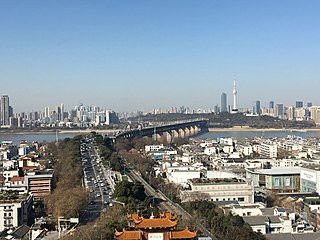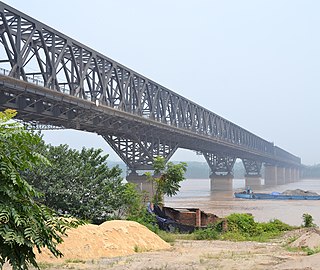
The Yangtze or Yangzi is the longest river in Eurasia, the third-longest in the world, and the longest in the world to flow entirely within one country. It rises at Jari Hill in the Tanggula Mountains of the Tibetan Plateau and flows 6,300 km (3,915 mi) in a generally easterly direction to the East China Sea. It is the seventh-largest river by discharge volume in the world. Its drainage basin comprises one-fifth of the land area of China, and is home to nearly one-third of the country's population.

The Yellow River or Huang He is the second-longest river in China, after the Yangtze River, and the sixth-longest river system in the world at the estimated length of 5,464 km (3,395 mi). Originating at an elevation above 15,000 feet in the Bayan Har Mountains in Qinghai province of Western China, it flows through nine provinces, and it empties into the Bohai Sea near the city of Dongying in Shandong province. The Yellow River basin has an east–west extent of about 1,900 kilometers (1,180 mi) and a north–south extent of about 1,100 km (680 mi). Its total drainage area is about 795,000 square kilometers (307,000 sq mi).

The Three Gorges Dam is a hydroelectric gravity dam that spans the Yangtze River by the town of Sandouping, in Yiling District, Yichang, Hubei province, central China, downstream of the Three Gorges. The world's largest power station in terms of installed capacity (22,500 MW), the Three Gorges Dam generates an average 95±20 TWh of electricity per year, depending on the annual amount of precipitation in the river basin. After the extensive monsoon rainfalls of 2020, the dam's annual production reached nearly 112 TWh, breaking the previous world record of ~103 TWh set by Itaipu Dam in 2016.

Wuhan is the capital of Hubei Province in the People's Republic of China. It is the largest city in Hubei and the most populous city in Central China, with a population of over eleven million, the ninth-most populous Chinese city and one of the nine National Central Cities of China.

Hubei is a landlocked province of the People's Republic of China, and is part of the Central China region. The name of the province means "north of the lake", referring to its position north of Dongting Lake. The provincial capital, Wuhan, serves as a major transportation hub and the political, cultural, and economic hub of central China.

The Three Gorges are three adjacent gorges along the middle reaches of the Yangtze River, in the hinterland of the People's Republic of China. With a subtropical monsoon climate, they are known for their scenery. The "Three Gorges Scenic Area" is classified as a AAAAA scenic area by the China National Tourism Administration.

Yichang, alternatively romanized as Ichang, is a prefecture-level city located in western Hubei province, China. It is the third largest city in the province after the capital, Wuhan and the prefecture-level city Xiangyang, by urban population. The Three Gorges Dam is located within its administrative area, in Yiling District.

The 1931 China floods, or the 1931 Yangtze–Huai River floods, occurred from June to August 1931 in China, hitting major cities such as Wuhan, Nanjing and beyond, and eventually culminated in a dike breach along Lake Gaoyou on 25 August 1931.

The Qing River is a right (southern) tributary of the Yangtze River in Hubei province of south-central China.

The South–North Water Transfer Project, also translated as the South-to-North Water Diversion Project is a multi-decade infrastructure mega-project in China. Ultimately it aims to channel 44.8 billion cubic meters of fresh water annually from the Yangtze River in southern China to the more arid and industrialized north through three canal systems:
Three Gorges Reservoir Region, including 25 county-level divisions of Chongqing municipality and Hubei province, is the region directly or indirectly involved in the submersion of the water storage of the reservoir region of the Three Gorges Dam.

Shennong Stream is a left tributary of the Yangtze River, located in the Hubei Province of central China. Fed by tributaries some of which come from the Shennongjia Forestry District, the stream flows south, falling into the Yangtze opposite the County of Badong.

The Wuhan Yangtze Great Bridge, commonly known as Wuhan First Yangtze Bridge, is a double-deck road and rail bridge across the Yangtze River in Wuhan, in Central China. At its completion in 1957, the bridge was the easternmost crossing of the Yangtze, and was often referred to as the "First Bridge of the Yangtze".

The baiji is a possibly extinct species of freshwater dolphin native to the Yangtze river system in China. It is thought to be the first dolphin species driven to extinction due to the impact of humans. This dolphin is listed as “critically endangered: possibly extinct” by the IUCN, has not been seen in 40 years, and several surveys of the Yangtze have failed to find it. In China, the species is also called the Chinese river dolphin, Han river dolphin, Yangtze dolphin and whitefin dolphin. Nicknamed the "Goddess of the Yangtze", it was regarded as the goddess of protection by local fishermen and boatmen. It is not to be confused with the Chinese white dolphin or the finless porpoise. This is the only species in the genus Lipotes.

The Zhicheng Yangtze River Bridge is a road-rail truss bridge across the Yangtze River at Zhicheng, Hubei Province in central China. The bridge is 1,742.3 metres (5,716 ft) long and carries two tracks of the Jiaozuo–Liuzhou Railway and road traffic. The bridge, built from 1965 to 1971, was the third road-rail crossing on the lower 2,884 km (1,792 mi) of the Yangtze below Yibin.
MV Dongfang zhi Xing was a river cruise ship that operated in the Three Gorges region of inland China. On the night of 1 June 2015, the ship was traveling on the Yangtze River when it capsized during a thunderstorm in Jianli, Hubei Province with 454 people on board. On 13 June, 442 deaths were confirmed, with 12 survivors. The passengers were mostly in their 60s and 70s, and mostly from Nanjing, where the ship started its cruise.
The prefecture-level city of Wuhan, the capital city of Hubei province, China, has a long and rich history that dates back over 3,500 years. Starting out from the Shang dynasty-era archaeological site at Panlongcheng associated with Erligang culture, the region would become part of the E state and Chu state during the Zhou dynasty. The region evolved into an important port on the middle reaches of the Yangtze River, and the cities of Hanyang, Hankou and Wuchang were united into the city of Wuhan in 1926. Wuhan briefly serving as the capital city of China in 1927 and in 1937. Modern-day Wuhan is known as 'China's Thoroughfare' (九省通衢) due to its status as a major transportation hub, with dozens of railways, roads and expressways passing through the city and connecting to other major cities.

The 1935 Yangtze flood struck China during a decade of flooding, famine and social turmoil. It is considered to be the fifth deadliest flood in recorded history, with a death toll of 145,000 and displacement of millions. As a result of the flood, millions of survivors were faced with hardship due to displacement, injury, loss of property as well as food shortages and famine.

In early June 2020, heavy rains caused by the regional rainy season led to floods severely affecting large areas of southern China including the Yangtze basin and its tributaries. Rains and floods extended to central and eastern China during July and were described as the worst since at least 1998.
Zheng Shouren was a Chinese engineer and chief designer of the Three Gorges Dam. He had been engaged in the planning and design of the Yangtze River Basin and major water conservancy projects for a long time and had published more than 60 papers and 4 books. He was a member of the Communist Party of China.
















